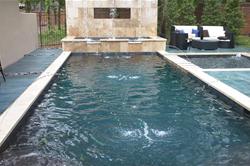Call Us Today!
SERVICES
Services - Our Journal
Where we break down the details baby!
Aqua-Blue Pool Deck Creates the Illusion of a Never-Ending Pool
Wednesday, October 5, 2011 at 5:59PM
Project submitted by Brock Lynch, BDC Ltd., Longview, Texas
By Anne Balogh, The Concrete Network

This broom-finished concrete deck, stained aqua-blue to match the color of the pool lining, gives the illusion of a never-ending body of water.
The challenge: To create a Zen-like atmosphere, the owners of this outdoor pool and spa wanted the deck surrounding it to echo the color and movement of the water, creating the feel of an expansive, floating pool. But they were unable to find any type of tile or slate to fit their vision. Knowing they did not want a solid-colored surface, they opted for stained concrete.
Design goals: "The homeowners contacted us through their pool builder, who recommended us for the staining of the pool deck," says Brock Lynch of BDC Ltd., a company specializing in all types of commercial and residential decorative concrete work. We stained this patio in a blend of blue and aqua stains. We tried as much as possible to match the color of the pool lining.
To add texture and create the illusion of rippling water, the surface was given a broom finish. Narrow channels were left between some of the concrete slabs and filled with blue-gray river rock, adding to the Zen-like feel.
Secrets to success: The biggest challenge on this project was getting the color just right, says Lynch. "We started with one coat of aqua-blue acid stain on the broom-finished deck, to create a natural-blue background color instead of the plain gray concrete. Once this was completed, we switched to a water-based stain. Referring to a stain color chart, we mixed a large batch of stain combining gray, blue, green, and black and applied it in two coats with an airless sprayer."
Protection of the existing surfaces before staining was paramount. "We tape off everything when we do a stain project. The last thing someone wants is to hire a contractor to clean up after another contractor," says Lynch.
For the final finish, the surface was coated with a high-solids solvent-based acrylic with grip enhancers stirred into it for slip-resistance. "After three to six years, it's always good to apply clear coat to a stained surface to keep the colors fresh and protect the surface," says Lynch.
This project is one of many that BDC Ltd. takes on for the opportunity to try something new with decorative concrete. "It's great to have people trust you to come up with ideas for their projects. That passion is what keeps me moving forward. Whether it's a concrete bartop for a trendy restaurant or an elementary school courtyard, we are always prepared to do something new."
Materials used
Aqua-blue acid stain: Kemiko
Water-based stains: Decorative Concrete Supply
Acrylic sealer: Decra-Seal, from W.R. Meadows
Grip enhancer: H&C SharkGrip
Contractor BDC Ltd.
Longview, Texas
Ironing Out the Wrinkles: How flat and level is your floor?
Wednesday, May 25, 2011 at 5:17PM
The world may not be flat but concrete floors are becoming flatter, to the point of becoming “super flat.”
The measurement of floor tolerances for “flatness” is being forced away from the era of the ruler and 10 foot straightedge into the era of the computer. The old way of determining floor flatness was accomplished by placing a 10-foot straightedge on the surface of the concrete and then measuring the gaps between the straightedge and the concrete with a ruler. The most common tolerance is “1/8 inch in 10 feet.”
Now there’s new technology that tosses the ruler and lets you measure floor flatness with speed, precision, and incredible accuracy.
Today's flat floors are found in more than ultra-sophisticated warehouses using unmanned forklifts, where the goods and parts may be stacked on shelves 20 feet or higher. Flatter and more level floors have been shown to be lower maintenance and provide an improved operational surface for many types of businesses. As a result, the demand for flatter floors is being seen in many different types of projects, from warehouses to retail store operations. This article provides you with important fundamentals about how flat floors are achieved and how they are measured.
To avoid the problems inherent with the old straightedge approach, a rigorous new statistically-based system was described by Allen Face in his 1985 Concrete International article “Specification and Control of Concrete Floor Flatness.” The birth of the F-number system was thus announced, and ACI adopted it in 1989.
Those mysterious F-numbers. The F-number system addresses both floor flatness and floor levelness. FF is the flatness number and defines the floor's characteristic curvature over 24 inches. FL is the levelness number and defines the floor's characteristic elevation difference over 10 feet. Both F-numbers are computed from successive point elevation measurements on 12 inch centers, and both numbers extend from zero to infinity: the larger the number, the more “flat” or “level” the floor. The system is perfectly linear so that a FF 30 / FL 24 floor is exactly twice as flat and twice as level as a FF 15 / FL 12 floor.
Don’t read this unless you’re a contractor. To avoid boundary problems, measurements are not taken within 2 feet of construction joints or other full-depth penetrations. To fairly gauge the installer's compliance with contract tolerances, measurements must be taken within 72 hours after finishing. If I were a concrete contractor, I would want the measurements taken the same day and before the curing compound is applied, since the floor will be its “flattest” right after it has been finished. With ongoing moisture loss and autogenous shrinkage, curling starts immediately and will continue to worsen for as long as 2 years, with the F-numbers decreasing accordingly.
— Philip Smith, P.E., FACI, ASTM; L&M Vice President, Technical Director, Resident Engineer; Phone: 800-362-3331, e-mail: philsmith@lmcc.com
Pavers to the rescue!
Monday, April 18, 2011 at 2:50PM
PAVING STONES ALLOW MRG TO MEET ZONING REGULATIONS
MRG Tool and Die in Faribault, Minn., wanted to double the size of its manufacturing facility, but zoning regulations stopped construction work because of its location within 1,000 feet of Faribault Lake, a reservoir on the scenic Cannon River.
County zoning regulations required the company to reduce the amount of impermeable surfaces on its property. Their solution was to install 20,000 square feet of Willow Creek Aqua-Loc Permeable Pavers (willowcreekpavingstones.com).
J D Rynders Inc. (j-d-rynders-inc.prior-lake.mn.paving.tel/) of Prior Lake, Minn., installed the pavers on the company's parking lots in order to meet the local zoning requirements. The alternative would have been to use permeable asphalt, but MRG CEO Mike Gramse said that product wasn't fully proven nor as attractive as the Aqua-Loc pavers.
The MRG Tool and Die (toolanddie.net) new facility parking lot was put to the test in September 2010 when up to 10 inches of rain fell on the site in a single day. "There was no water sitting in that parking lot," he said. "It ran through like it was supposed to. So far, it's working out real good. It's holding up well. We get a lot of nice compliments on it."
This article appears in the March 2011 issue of Concrete Monthly.
What is the latest in diamond blades for gas-powered cut-off saws?
Monday, April 18, 2011 at 2:38PM
DTEC: Diamond blades
Dtec, a product division of Affinity Tool Works, has introduced a new line of diamond blades to its Superior Series for gas-powered cut-off saws. With a segmented rim style, specially-designed features and durable construction, the 12- and 14-inch Superior blades offer a high-performance addition to the complete Dtec diamond blade offering. Designed to provide fast, clean, and quality cuts with extended blade life, the Superior series is ideal for professionals in the concrete, masonry, construction, and landscape and hardscape industries.
The Dtec Superior blades offer the ability to cut through steel, an ideal solution for cutting reinforced concrete and masonry on applications such as bridge decks and highways. The versatility of the blades is not limited to concrete and steel. Rather, the blades are able to cut numerous jobsite materials, including concrete pavers, masonry block and brick, as well as high-end material like granite, stone and tile.
Contact Us
Thank you for contacting us.
We will get back to you as soon as possible.
We will get back to you as soon as possible.
Oops, there was an error sending your message.
Please try again later.
Please try again later.
Share
Tweet
Share
Mail
Share
Tweet
Share
Mail
Share
Tweet
Share
Mail
Address
Payment Options



Content, including images, displayed on this website is protected by copyright laws. Downloading, republication, retransmission or reproduction of content on this website is strictly prohibited. Terms of Use
| Privacy Policy
